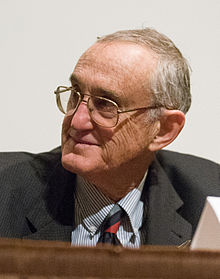David Lee (physicist)
| David Morris Lee | |
|---|---|

David Morris Lee in 2007
|
|
| Born |
January 20, 1931 Rye, New York |
| Fields | Physics |
| Institutions |
Cornell University Texas A&M University (2009-present) |
| Alma mater |
Yale University University of Connecticut Harvard University |
| Doctoral advisor | Henry A. Fairbank |
| Notable awards |
Nobel Prize in Physics (1996) Oliver Buckley Prize (1981) Sir Francis Simon Memorial Prize (1976) Oliver E. Buckley Condensed Matter Prize (1970) |
| Spouse | Dana (2 children) |
David Morris Lee (born January 20, 1931) is an American physicist who shared the 1996 Nobel Prize in Physics with Robert C. Richardson and Douglas Osheroff "for their discovery of superfluidity in helium-3."
Lee was born and raised in Rye, New York. His parents, Annette (Franks), a teacher, and Marvin Lee, an electrical engineer, were children of Jewish immigrants from England and Lithuania. He graduated from Harvard University in 1952 and then joined the U.S. Army for 22 months. After being discharged from the army, he obtained a master's degree from the University of Connecticut. In 1955 Lee entered the Ph.D. program at Yale University where he worked under Henry A. Fairbank in the low-temperature physics group, doing experimental research on liquid 3He.
After graduating from Yale in 1959, Lee took a job at Cornell University, where he was responsible for setting up the new Laboratory of Atomic and Solid State Physics. Shortly after arriving at Cornell he met his future wife, Dana, then a PhD student in another department; the couple went on to have two sons.
Lee moved his laboratory from Cornell to Texas A&M University on November 16, 2009.
In the summer of 2016, Lee lost his wife, Dana, due to un-diagnosed health issues.
The work that led to Lee's Nobel Prize was performed in the early 1970s. Lee, together with Robert C. Richardson and graduate student, Doug Osheroff used a Pomeranchuk cell to investigate the behaviour of 3He at temperatures within a few thousandths of a degree of absolute zero. They discovered unexpected effects in their measurements, which they eventually explained as phase transitions to a superfluid phase of 3He. Lee, Richardson and Osheroff were jointly awarded the Nobel Prize in Physics in 1996 for this discovery.
...
Wikipedia
